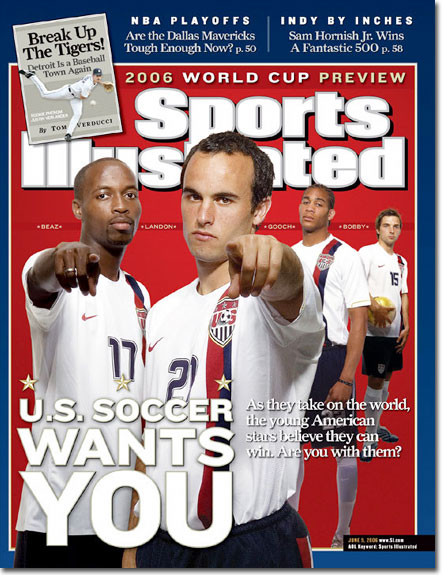Written in 2009 by Kelsey Ontko, Julia Fogleman and Lucas Nevola
Edited and Updated in 2013 by Matt Darlow, Dan Carp, Bryan Silverman and Matt Berezo
What Constitutes the Soccer Market in the U.S.?
Soccer in the U.S. is a widely popular recreational sport for boys and girls. However, as a spectator sport, soccer is largely overshadowed by American football, baseball, basketball, and hockey. The United States has a professional first-division men’s league, Major League Soccer, which is comprised of 19 teams. Previous leagues in the United States, like the NASL and the WUSA, folded after losing millions of dollars. The MLS currently survives with a very structured pay system, where the lowest paid players can make as little as thirty-five thousand dollars a year.
When did the United States officially become a member of FIFA?
The official governing body of soccer in America today, the United States Soccer Federation, was officially recognized by FIFA in 1913. However, before the term soccer was coined, the governing body of the sport was called the Football Association. Although the form of soccer as we know it today was not formally recognized in the U.S. until the 20th century, the roots of the game in America go back much further. The first US soccer match under Football Association rules was played on November 6, 1869 between Princeton University and Rutgers University. Throughout the nineteenth century, the rules of the game evolved to emulate rugby, and eventually produced American football.
Why is the soccer market weaker in the U.S. compared to the rest of the world?
Striving to Take Root in America
In an effort to heighten the popularity of men’s professional soccer in the U.S., the United States Soccer Federation is continuously vying for the opportunity to host future World Cups. After hosting the 1994 World Cup, U.S. Soccer feels that the media attention associated with hosting the world’s most-viewed tournament will once again make a positive impact on soccer in America.
To learn more about soccer in the U.S., visit the pages available through the drop-down menu above.
How to cite this article: “The Soccer Market in the U.S.,” Written by Kelsey Ontko, Julia Fogleman and Lucas Nevola (2009), Edited and Updated by Matt Darlow, Dan Carp, Bryan Silverman and Matt Berezo (2013), Soccer Politics Pages, Soccer Politics Blog, Duke University, http://sites.duke.edu/wcwp (accessed on (date)).


Dear Alexandre: Many thanks for your note and your questions. This is a vast question, with a rather complex answer. But one big key is that, in contrast to the situation in France and indeed in most of the world, the university system in the U.S. is one of the central sites for the training and formation of athletes, including in soccer. Before the university, however, most players come up through a series of leagues and academies, many of them extremely well organized, that are regionally based. Your best bet if you were to pursue this project would probably be to make contact with soccer programs at U.S. universities, who provide a sort of pivot point within the broader system.
I hope that helps!
Hello,
My name is Alexandre Avignon, I’m French and I’m running for a Master in sports management. I am currently make a project on the theme of the creation of a football training center in the United States. The particularity of this training center is that it must draw on the methods of European centers. A kind of management at the European center located in the USA.
I would like to know if it was possible to obtain some informations from you in order to complete my project, in order to have information on the procedures, conditions and benefits of setting up a training center for football United States.
My plan is based on 3parties:
– First, it will focus on the presence of soccer training center in the USA: What there exists in the U.S. in terms of traditional training center for football (soccer)? How many are there? What difference is there with the European model? Methods of recruitment and training centers in American soccer?
– Second, the project will speak about the construction of a soccer training center in the USA: What are the administrative procedures for foreigners wishing to settle in the U.S.? Are there specific conditions for foreign companies? What are the benefits and limitations for a center that wishes to impose its european management ? What business model?
– A third party would be the place could have such a center in the USA: how to impose a European model of recruitment and training in the U.S.? What are the messages to be conveyed to attract future professionals soccermans? How to export our model in the U.S.?
The goal is to come to understand the methods of recruitment and training in the U.S. and compare them with the European model and then show what would be the benefits to be gained for both the player and the Centre.
Do you have documents or contacts that could be respond to my request?
If you do not have info or you do not want to give, perhaps you know an organization or a center that would be likely to answer my questions?
I hope not to annoy you with my questions but know that this project is of great importance in the context of my studies.
Waiting a response from you, I wish you a good day.
Best Regards
Alexandre Avignon